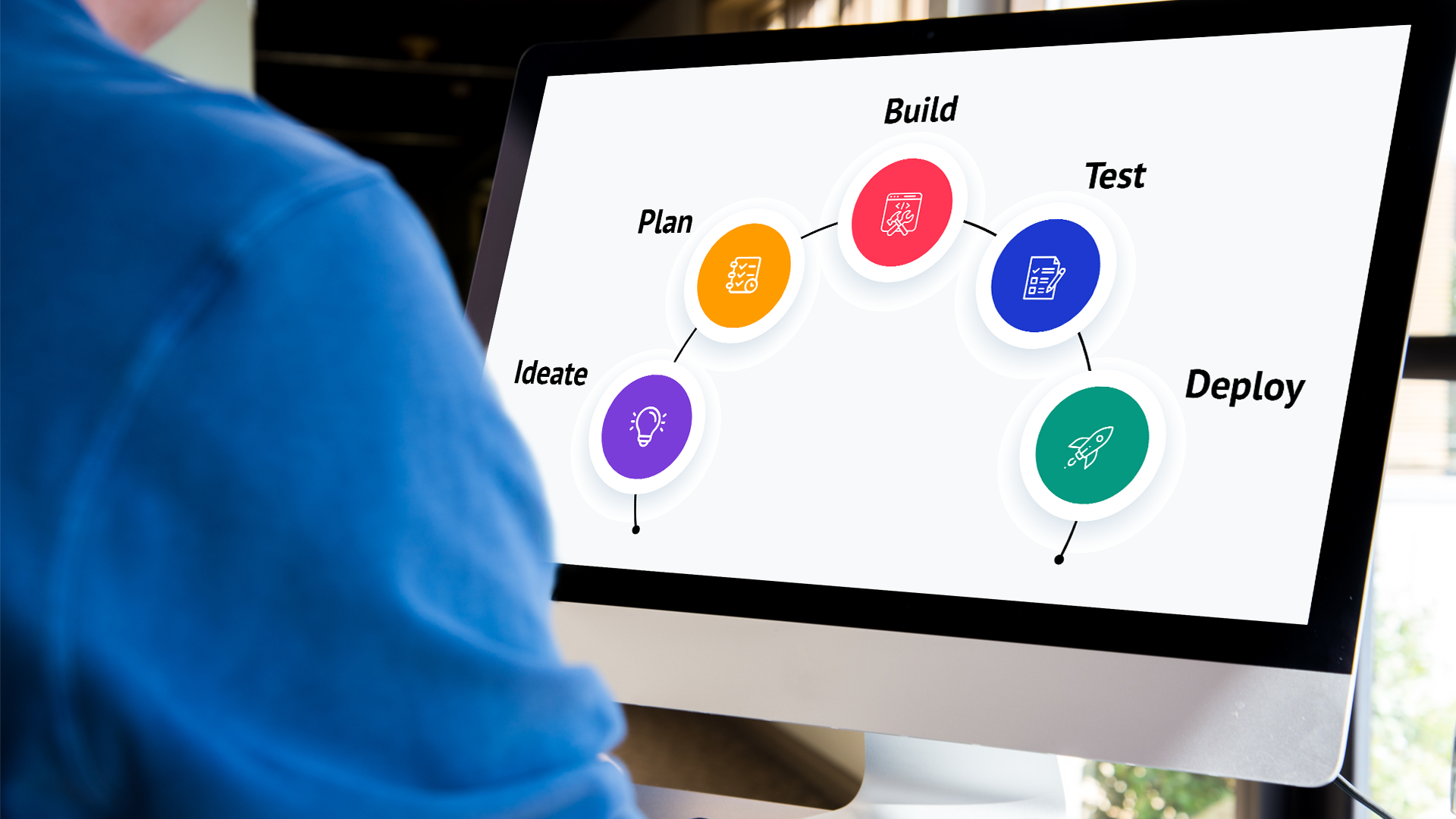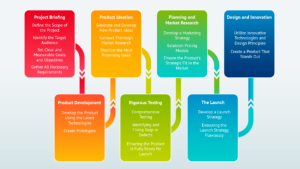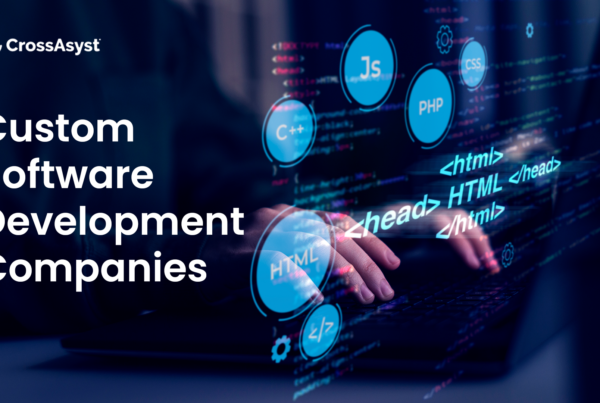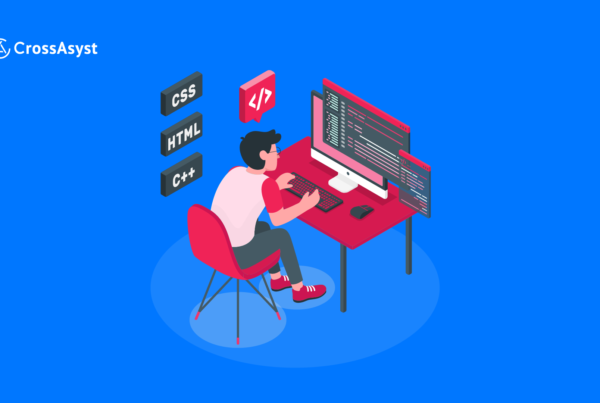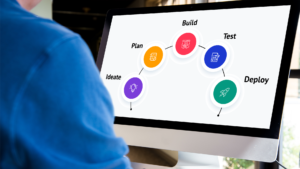
In today’s day and age, innovation and technology go hand in hand. However, not everyone who has the ideas to innovate necessarily has the technical skills required to build the product itself. This is especially true in the field of software development.
Of course, there are software development companies, such as CrossAsyst, that are capable of bringing your vision to fruition by custom building your software or application. In fact, a 2022 study showed that 79% of all software development in the US was outsourced.
However, it is important for every stakeholder to fully understand every component of the product development process. This knowledge will ensure clarity in every step of the process, from ideation to launching the finished product.
Here’s a quick read about what the ideal product development process looks like in 2023.
Table of Contents
What is the Product Development Process?
The product development process is a systematic approach to creating new products or enhancing existing ones. It encompasses a series of structured steps that guide a concept from ideation to launch. This process is critical for businesses looking to bring innovative, competitive, and high-quality products to market efficiently.
A Step-By-Step Guide to the Product Development Process
The product development process can be broken down into seven steps.
Step 1. Project briefing
Step 2: Product ideation
Step 3: Planning and market research
Step 4: Design and innovation
Step 5: Product development
Step 6: Rigorous testing
Step 7: The launch
Each of these can be further broken down into smaller steps. Let’s take a more detailed look at each component of the product development process.
Step 1: Project Briefing
The product development journey commences with a critical first step, project briefing. This initial phase is pivotal in laying the foundation for a successful product development process. Here’s a closer look at the key elements involved in the project briefing.
Define the Scope of the Project
Clearly outlining the project’s scope is essential. This means defining the boundaries of what the product will and won’t encompass. It sets the expectations and prevents scope creep, ensuring that the project stays on track.
Identify the Target Audience
Understanding your target audience is fundamental to developing a product that resonates with users. This involves creating detailed user personas and delving into the demographics, preferences, and pain points of your intended customers.
Set Clear and Measurable Goals and Objectives
Establishing specific, measurable, achievable, relevant, and time-bound (SMART) goals and objectives is crucial. These goals act as guiding stars throughout the development process, helping the team stay focused and motivated.
Gather All Necessary Requirements
Gathering comprehensive requirements is essential to ensure that nothing is missed during the development process. This includes functional requirements (what the product should do) and non-functional requirements (how it should perform).
A well-defined project briefing is the compass that points the project in the right direction. It acts as a reference point for all team members, aligning their efforts and expectations as they move forward.
Step 2: Product Ideation
Product ideation is where creativity and innovation take center stage. Here’s what happens during this phase.
Generate and Develop New Product Ideas
Teams brainstorm, allowing creativity to flow freely. New product concepts are generated, and the focus is on thinking outside the box.
Conduct Thorough Market Research
Generating ideas is not enough; they must be validated by conducting comprehensive market research. This step ensures that the ideas align with market demands and customer needs. It also helps in identifying potential gaps and opportunities in the market.
Shortlist the Most Promising Ideas
Not all ideas are created equal. Teams evaluate and prioritize the generated ideas, selecting the most promising ones to move to the next stage. These ideas have the potential to address identified market needs and offer value to customers.
Effective idea generation is at the heart of innovation and a key driver of successful product development. It’s about finding the right balance between creativity and practicality.
Step 3: Planning and Market Research
Planning and market research represent the bridge between conceptualizing a product and preparing to bring it to market. Here’s what’s involved.
Develop a Marketing Strategy
A robust marketing strategy is critical for successful product promotion. It outlines how you will reach and engage your target audience, making them aware of your product and its value.
Establish Pricing Models
Pricing is a delicate balance that must be struck. The model chosen should make sense for both your product and your customers. It should reflect the product’s value while remaining competitive in the market.
Ensure the Product’s Strategic Fit in the Market
It’s essential to ensure that the product aligns with your overall business strategy and its place within the market. This means assessing its competitive position, differentiation, and market fit.
Thorough planning and market research ensure that the product is well-positioned for a successful launch. This step lays the groundwork for effective marketing and sales strategies.
Step 4: Design and Innovation
This stage focuses on the aesthetics and user experience of the product. Here’s what it entails.
Utilize Innovative Technologies and Design Principles
Incorporate cutting-edge technologies and design principles to create a product that not only looks good but also functions efficiently.
Create a Product That Stands Out
Your product should stand out from the competition. It should not only meet users’ functional needs but also provide an engaging and memorable experience, making it unique in the market.
Innovation in design is crucial because it’s often the first aspect of the product that customers interact with. A visually appealing and user-friendly design can set the product apart from competitors and create a lasting impression.
Step 5: Product development
In this phase, the focus is on bringing the product from concept to reality. Here’s what to expect.
Develop the Product Using the Latest Technologies
The product is built using the latest technologies and development methodologies. This ensures that it’s technically advanced and capable of meeting user expectations.
Create Prototypes
Prototyping is an essential part of this step. It involves building models of the product to test and refine its functionality and design. Prototyping helps identify and address potential issues before moving further in the development process.
Step 6: Rigorous testing
Testing is a process that endures through various stages of the product development process. Here’s a quick overview of what ought to be included during testing.
Comprehensive Testing
Every stage of the development process involves rigorous testing. This includes unit testing, integration testing, and user testing to ensure that all aspects of the product function as intended.
Identifying and Fixing Bugs or Defects
Any bugs, defects, or issues discovered during testing must be addressed promptly. This ensures that the product is free of critical flaws that could negatively impact user experience.
Ensuring the Product Is Fully Ready for Launch
Comprehensive testing ensures that the product is thoroughly evaluated and refined, making it ready for a successful market launch.
Rigorous testing is critical to prevent post-launch issues and maintain product quality.
Step 7: The Launch
Finally, your new product is launch ready. Here’s what launching a new product entails.
Develop a Launch Strategy
Creating a well-defined launch strategy is essential. This strategy takes into account market trends, user adoption, and growth opportunities. It outlines how the product will be introduced to the market and the steps needed for a successful launch.
Executing the Launch Strategy Flawlessly
It’s not just about having a plan; it’s about executing it flawlessly. All the prior efforts culminate in this step, and a successful launch is the outcome of careful planning and execution.
A successful launch is vital to the success of your product, as it determines how well the product is received in the market and how quickly it gains traction with users.
Why You Need a Well-Defined Product Development Process
Now that we’ve outlined the product development process, let’s explore why it’s so essential for your business.
Increased Efficiency and Productivity:
- A structured process streamlines tasks, reducing inefficiencies and unnecessary delays.
- It minimizes redundancy by providing a clear roadmap for each step, preventing wasted effort.
- By providing a well-defined framework, it accelerates product development, ensuring that your product reaches the market faster.
Improved Product Quality
- With a well-defined process, the team has a clear understanding of the product’s objectives, requirements, and specifications.
- Rigorous testing at every stage helps identify and rectify issues early in the development cycle, leading to a product that’s more likely to be of high quality.
- Meeting or even exceeding customer expectations becomes more achievable when product quality is consistently maintained and improved upon.
Reduced Risk of Product Failure
- Systematic planning, risk assessment, and continuous testing are key components of a well-defined product development process.
- Early identification of potential risks allows for timely mitigation, significantly reducing the likelihood of a product failing in the market.
- By systematically addressing risks and issues, you can make more informed decisions to ensure the product’s success.
Improved Communication and Collaboration
- A well-defined process enhances communication and collaboration among team members.
- Everyone involved in the project, from designers to developers and marketers, works from a shared understanding of the project’s goals and progress.
- This alignment ensures that everyone is working towards a common goal, avoiding misunderstandings and conflicts that can hinder progress.
Increased Customer Satisfaction
- The ultimate goal of any product development process is to create products that meet or exceed customer needs.
- By following a structured approach, the product development team is more likely to identify and address these needs effectively.
- The result is products that resonate with customers, leading to increased satisfaction, loyalty, and positive word-of-mouth.
Build the Future With Crossasyst Today
In essence, a well-defined product development process is not just about delivering a product. It’s about delivering a product that meets or exceeds customer expectations, is efficient to create, and has a reduced risk of failure.
Such a process doesn’t just benefit your business; it also enhances the experience and satisfaction of your customers, which, in turn, contributes to your long-term success in the market.
With CrossAsyst, you get all this and then some. Our team is dedicated to understanding your vision and objectives thoroughly, while working with you to build future-ready products designed to not just lead, but disrupt markets.
Our domain knowledge spans industries and verticals, so rest assured, CrossAsyst is more than capable of building products that appeal to your target demographic and will establish your unique market presence.
Our team is invested in more than just building you a custom software solution; we’re invested in your success. You can expect CrossAsyst to seamlessly guide you through every step, from ideation to launching your product.
With our use of agile methodologies, cutting edge technologies and a design principle that amalgamates the best of aesthetics, usability and accessibility, you can be guaranteed that your product will not only hit the market faster than anticipated, but will surpass all expectations.
Get in touch with CrossAsyst today to start building the technology that will define the future.
